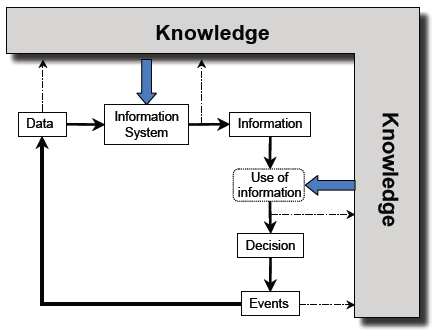Understanding the Difference among Knowledge,
Data and Information
Example: Bits representing score
on examination including score in test 1 and score in test 2.
Information
is data with context and relevance. While data are nothing but useless garbage
bits and uninterpretable zeroes and ones, information can be used to obtain a
more meaningful indication of trends and patterns.
Example: In a test, the result of
the frequency of errors interprets if the item is too difficult or too easy to
answer.
Knowledge
is information with decision-making and action-directed utility and purpose.
Knowledge is the highest level in the hierarchy, with information in them
middle, and data ot be at the lowest level. This is the richest, deepest and
most valuable of the three.
Example: The information in the
frequency error and score of test items shows the validity of each item in the
test if there's a need to be retained or to be revised.
Knowledge is the information that
helps to produce information from data or produce valuable information from
less valuable information.
Types of Knowledge
Epistemology is the branch of philosophy that studies the
nature of knowledge, its presuppositions and foundations, and its extent and
validity (American Heritage Dictionary of
the English Language, Fourth Edition.
There are many classifications
and characterizations of types of knowledge, e.g. individual, social, causal,
conditional, relational, pragmatic encoded, encoded and procedural. It is very
important to know what knowledge is before we can manage it effectively.
Subjective View of Knowledge
In this kind of view, reality is
entirely dependent on human perception and is socially constructed through
interaction and individuals.
·
Knowledge is
not an independent object
·
Knowledge
has no single location
·
Knowledge is
viewed as an on-going accomplishment
Objective View of Knowledge
In objective view of knowledge,
reality is independent of human perceptions and can be structured in terms of
priori categories and concepts.
·
Knowledge is
something that can be stored, transferred, and manipulated
·
Knowledge
enables access and utilization of information
·
Knowledge is
a strategic capability that can potentially be applied to seek a competitive
advantage
advantage
Procedural vs. Declarative Knowledge
Declarative Knowledge focuses on beliefs about relationships among
variables.
Example: “All other things being
equal, greater price charge for a product would cause some reduction in its
number of sales.”
It can be stated in the form of
logical propositions, expected correlations, or formulas relating concepts
represented as logical symbols and/or mathematical variables. This is often
characterized in KM circles as “know-what.”
Procedural Knowledge focuses on beliefs relating procedures or
processes: sequences or steps or actions to desired or undesired outcomes.
It is often characterized in KM
circles as “know-how.”
Tacit vs. Explicit
Tacit Knowledge includes insights, intuitions, and hunches
that are not verbalized or documented. This is usually difficult to express and
formalized. Therefore, it is difficult to share. It is a phenomenon wherein the
employee can’t really tell how to do something.
Explicit Knowledge refers to knowledge that has been expressed
into words or numbers. It can be shared formally and systematically in the form
of data, specifications, manuals, drawings, audio or video tapes, computer
programs, patents, etc.
Can we convert explicit knowledge to tacit
knowledge?
We often convert explicit
knowledge to tacit knowledge. It usually happens when an individual reads a book
and learns some insights from it, but not by rote memorization.
Can we convert tacit knowledge to explicit
knowledge?
We can sometimes convert tacit
knowledge to explicit knowledge. It happens when an individual, who has a lot
of tacit knowledge, writes a book formalizing that knowledge. More often, it is
like difficult conversion that requires hard efforts.
General vs. Specific Knowledge
General Knowledge is possessed by a large number of
individuals and can be transferred easily across individuals.
Example: Headache is one symptom
of brain hemorrhage.
Specific Knowledge (idiosyncratic knowledge) is possessed by a very limited number of
individuals, and is expensive to transfer.
Example: How to operate on a
patient suffering a stroke.
Technically vs. Contextually Specific
Knowledge
Technically Specific Knowledge is a deep knowledge about a specific area.
It includes tools and techniques for solving problems. It is often acquired
through formal training and experience in the field.
Examples:
- The scientific knowledge of a marine biologist
- The knowledge about computer hardware by an engineer
Contextually Specific Knowledge refers to the knowledge of particular
circumstances of time and place in which work is to be performed. It can not be
acquired through formal training.
Examples:
- The detailed knowledge that design engineers possessed about the idiosyncrasies of the particular design group they are working
- Basketball forward detailed knowledge about the team’s center
Reference:
Becerra-Fernandez, I. and Sabherwal, R. (2010). Knowledge Management: Systems and Processes. New York: ME Sharpe, Inc. 










